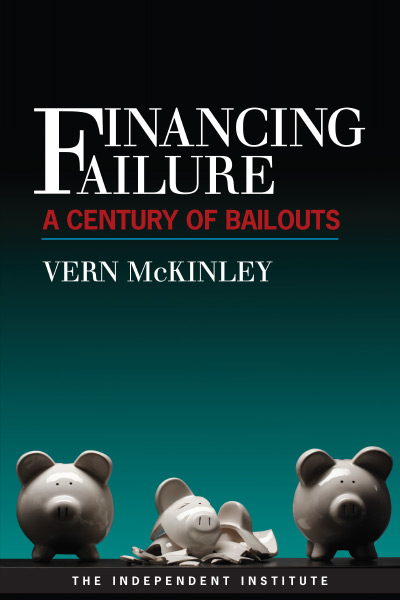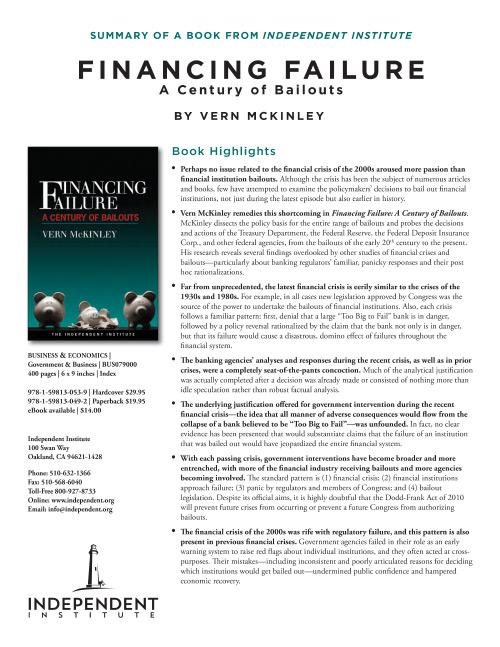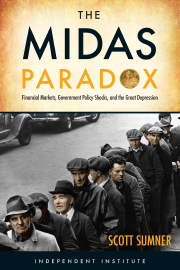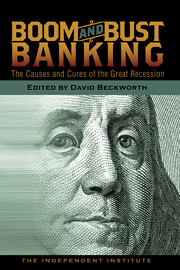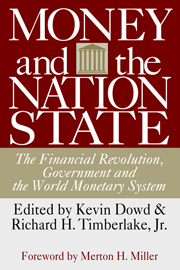| Price: | $19.95 |
| Formats |
Paperback (ISBN 978-1-59813-049-2) |
Hardcover (ISBN 978-1-59813-053-9) |
| Price: | $19.95 |
| Formats |
Paperback (ISBN 978-1-59813-049-2) |
Hardcover (ISBN 978-1-59813-053-9) |
Overview
During the recent financial crisis no issue has aroused more passion than financial institution bailouts. The standard rationale for the bailouts has been one of necessity and fear: federal regulatory agencies must have more authority in order to respond to the crisis, or else the public will face terrible consequences. But does this rationale hold up to close inspection?
In Financing Failure, Vern McKinley approaches the topic by examining the policy decisions behind the bailouts and by showing their connection to previous government interventions. He brings under scrutiny the policy decisions made by the Treasury Department, the Federal Reserve, and the FDIC during the crisis of the 2000s and links them to policies that go back as far as the 1930s. This history of bailouts reveals that the genesis of financial crisis is government policy, be it the mismanagement of monetary policy during the 1930s or the political push to expand homeownership that helped cause the 2000s crisis.
The nation’s federal financial regulators and the politicians claim to have saved the American economy. In truth they have done everything within their power to expand their own influence—often far out of view from the public and media. Instead of openly explaining their actions, the bailout agencies have attempted to prevent the public from reviewing their decision-making, often at tremendous cost to taxpayers. McKinley’s painstakingly researched and clear-headed analysis of bailouts and government intervention shows that the American public has accepted too many official pronouncements at face value, and that reining in the federal regulators is a necessary step toward truly promoting the safety and soundness of the financial system.
Contents
Acknowledgments
Financial Scorecard
Introduction1. Bear Stearns-The Original Sin
2. Bailouts 101
3. The Depression of the 1930s and the Interventions
4. After the Depression
5. 1980s Financial Crisis and the Interventions
6. After the 1980s Financial Crisis
7. The 2000s Crisis: The Fed and Treasury Intervene
8. The 2000s Crisis: The FDIC Intervenes
9. The 2000s Crisis: TARP
10. Will the Dodd-Frank Changes Stop the Bailouts?
11. The Assessment of the HistoryAppendix The Freedom of Information Act Lawsuits
Index
About the Author
Detailed Summary
- Perhaps no issue related to the financial crisis of the 2000s aroused more passion than financial institution bailouts. Although the crisis has been the subject of numerous articles and books, few have attempted to examine the policymakers’ decisions to bail out financial institutions, not just during the latest episode but also earlier in history.
- Vern McKinley remedies this shortcoming in Financing Failure: A Century of Bailouts. McKinley dissects the policy basis for the entire range of bailouts and probes the decisions and actions of the Treasury Department, the Federal Reserve, the Federal Deposit Insurance Corp., and other federal agencies, from the bailouts of the early 20th century to the present. His research reveals several findings overlooked by other studies of financial crises and bailouts—particularly about banking regulators’ familiar, panicky responses and their post hoc rationalizations.
- Far from unprecedented, the latest financial crisis is eerily similar to the crises of the 1930s and 1980s. For example, in all cases new legislation approved by Congress was the source of the power to undertake the bailouts of financial institutions. Also, each crisis follows a familiar pattern: first, denial that a large “Too Big to Fail” bank is in danger, followed by a policy reversal rationalized by the claim that the bank not only is in danger, but that its failure would cause a disastrous, domino effect of failures throughout the financial system.
- The banking agencies analysis and response during the recent crisis, as well as in prior crises, was a completely seat-of-the-pants concoction. Much of the analytical justification was actually completed after a decision was already made or consisted of nothing more than idle speculation rather than robust factual analysis.
- The underlying justification offered for government intervention during the recent financial crisis—the idea that all manner of adverse consequences would flow from the collapse of a bank believed to be “Too Big to Fail”—was unfounded. In fact, no clear evidence has been presented that would substantiate claims that the failure of an institution that was bailed out would have jeopardized the entire financial system.
- With each passing crisis, government interventions have become broader and more entrenched, with more of the financial industry receiving bailouts and more agencies becoming involved. The standard pattern is (1) financial crisis; (2) financial institutions approach failure; (3) panic by regulators and members of Congress; and (4) bailout legislation. Despite its official aims, it is highly doubtful that the Dodd-Frank Act of 2010 will prevent future crises from occurring or prevent a future Congress from authorizing bailouts.
- The financial crisis of the 2000s was rife with regulatory failure, and this pattern is also present in previous financial crises. Government agencies failed in their role as an early warning system to raise red flags about individual institutions, and they often acted at cross-purposes. Their mistakes—including inconsistent and poorly articulated reasons for deciding which institutions would get bailed out—undermined public confidence and hampered economic recovery.
Polls conducted during the peak of the recent financial crisis showed that public opinion was overwhelmingly opposed to the bailout of banks and other financial institutions. If bailouts are very unpopular with the American public, why did elected officials give financial regulators greater authority to implement them? And how exactly did regulators decide when to bail out a troubled financial institution and when not to do so?
In Financing Failure: A Century of Bailouts, Vern McKinley, a former legal advisor and analyst for several U.S. regulatory agencies, addresses these questions and many others related to federal agencies’ decision to save financial firms from collapse. Employing a masterful command of the available evidence, he dissects the policy basis for the entire range of financial bailouts and probes the decisions and actions of the Treasury Department, Federal Reserve, Federal Deposit Insurance Corp., and other agencies, from their inception to the present.
Financing Failure not only shows why government regulators and politicians have become so reliant on bailouts, but it also depicts their habitually dysfunctional modus operandi during a crisis, often characterized by false assumptions and a panic-driven, “not on my watch” approach to policy implementation.
“The usual pattern is that they overreact in the midst of a financial crisis because they feel they have to ‘do something,’” McKinley writes in his concluding chapter. “Most of these actions made matters worse both in the short term, as the panic spread more broadly, and in the long term, as unintended consequences flow from their initial reaction.”
Financing Failure can be read profitably by a general audience, but readers with backgrounds in banking, finance, or government affairs will especially appreciate the thoroughness of its account of the rise of massive bailouts and the bureaucratic decision-making that has rationalized them.
Bear Stearns and the Nature of Bailouts
Financing Failure begins by recounting the first bailout of the financial crisis of 2008–2009, the original sin as it has been called. In March 2008, following a sharp drop in its liquidity, Wall Street behemoth Bear Stearns found itself in serious trouble: an unusually large number of customers were withdrawing their funds from it, and corporate lenders were unwilling to lend it funds necessary to continue its operations. Unless the firm found relief immediately, it would be forced to shut down and many customers and clients would be left in the lurch. A series of late-night phone calls and emails led to a solution: JPMorgan Chase would provide a short-term loan, but only if the Federal Reserve Bank of New York would lend it funds via the so-called discount window. Worried that the failure of Bear Stearns would take down the banks with which it was doing business, the Federal Reserve Board agreed to the transaction and JPMorgan Chase was able to save Bear Stearns from immediate collapse. The seat-of-the-pants effort of the Fed also characterized later panicky regulatory responses to the crisis.
The Fed’s indirect bailout of Bear Stearns illuminates many of the issues surrounding the subprime mortgage loan implosion that began two years earlier and the events that followed. But a solid understanding of the causes and consequences of bailouts requires answers to fundamental questions: What does it mean when a financial institution fails or suffers a run? What is the role of a central bank in addressing failures and runs? What constitutes a bailout? Answers to these questions explain the nature of bailouts and the evolution of central-bank lending. They also shed light on the legacies of financial regulations enacted in the twentieth century.
The Great Depression and Its Aftermath
Although the Federal Reserve Act of 1913 was supposed to end financial panics, the average number of bank failures grew by several hundred each year in the decade that led up to the stock market collapse of October 1929. Bank failures became even more common during the Great Depression, peaking at an estimated 4,000 in 1933. President Hoover created the Reconstruction Finance Corporation (RFC) to reduce the incidence of bank failures and restore depositors’ confidence in the bank system by providing secured loans to unsound banks. Bank failures continued until the agency was given authority to purchase preferred shares of banks and become heavily involved in the management of selected banks. The reduction of bank failures came at the price of reduced market discipline that acts to punish poorly managed banks.
In the early 1950s, Congress phased out the RFC and gave the Federal Deposit Insurance Corporation (FDIC) new powers to assist troubled banks, including the authority to bail out creditors and shareholders of banks in danger of closing, a power not used until 1971. The FDIC faced one of its greatest challenges in 1974 when Franklin National Bank of New York, one of the twenty largest U.S. banks, experienced a massive run and lost nearly 50 percent of its deposits. The FDIC, the Federal Reserve, and the Office of the Comptroller of the Currency reacted by arranging a bailout of uninsured creditors and depositors. Federal regulators worried that without a bailout, financial markets would have been severely disrupted, but no regulator has ever released a detailed analysis of the expected disruption. The Franklin resolution marked a turning point: it was the first bailout of an institution deemed “Too Big to Fail” (TBTF), and it foreshadowed the method of future bank resolutions. It also suggested the lengths to which banking agencies would go to avoid the least hint of financial instability.
The 1980s Financial Crisis and Its Legacy
The 1980s saw the greatest volatility of the U.S. financial system since the Great Depression, with the number of failed banks and savings and loans (S&Ls) growing significantly until the end of the decade. The number of bailouts also grew. The bailout of Continental Illinois, the seventh largest bank in the country at the time, was the most significant of the era—another case of “Too Big to Fail.” By the late 1980s and early 1990s, the industry concluded that the safety net had been broadened too much and that the “Too Big to Fail” doctrine had to be reversed. Big banks, one industry spokesperson testified, neither wanted nor needed TBTF.
Policymakers debated whether to allow TBTF interventions only when a bank failure posed a “systemic risk” to the financial system. Proponents of TBTF had no evidence to support their claim that particular bailouts were necessary to prevent the entire financial system from collapse. Unlike during the Great Depression, where there was evidence of a dramatic drop in bank deposits and a flight to currency, no data was presented of a similar effect during the 1980s that would justify bailing out the largest financial institutions. Although Democrats in the House of Representatives pushed to end TBTF, the final version of the 1991 reform legislation—the Federal Deposit Insurance Corporation Improvement Act (FDICIA)—left TBTF in place. FDICIA also gave the Federal Reserve new powers to lend to securities firms.
The 2000s Crisis
The financial crisis of the 2000s surprised the heads of the Federal Reserve, the Treasury Department, and the FDIC, but their responses should have surprised no one: they repeated their predecessors’ reactions to the bank and S&L crises of the 1980s by undertaking bank closings, massive ad hoc bailouts, and efforts to acquire new powers. Under Chairman Ben Bernanke, the Fed took the lead in shielding the identities of weak institutions, supposedly so that none would be stigmatized in the marketplace and suffer further losses.
False narratives prevailed about why a particular firm was bailed out (Bear Stearns, AIG) or not (Lehman Brothers). In reality, it was far from clear that a Bear Stearns’ bankruptcy would have instigated a financial meltdown, nor was it clearly a mistake to have let Lehman file for bankruptcy. Nor was AIG’s collapse caused by the firm’s exploitation of a gap in the supervisory system: the Office of Thrift Supervision had monitored AIG and believed the insurance giant had enough liquidity to weather losses from its credit default swaps.
Fannie Mae and Freddie Mac faltered during the 2000s crisis much more than during the 1980s crisis. In the mid-1990s, they began to move into the subprime-mortgage market due to pressure from the White House and Congress to fulfill affordable-housing goals. Unfortunately, just as the mortgage market began to deteriorate in 2007, the constraints on Fannie and Freddie were loosened. Secretary Henry Paulson and Chairman Bernanke testified that the agencies were “well capitalized,” but a different story was suggested by the passage of the Housing and Economic Recovery Act of 2008. Although it granted the Treasury broad powers to support the agencies and created a new oversight authority, large foreign investors were not reassured and both Fannie and Freddie were placed under government conservatorship.
FDICIA, the 1991 reform, allowed for the bailout of firms believed to pose a risk to the financial system. This exemption created strong incentives for consolidation in the banking industry in the 1990s and 2000s and may explain the proliferation of megabanks during the period. But the law provided no guidance for determining when systemic risk was present. Hence a few differences of opinion arose among the bailout agencies. For example, the FDIC—against pressure from Treasury—decided to close Washington Mutual and cover insured depositors rather than to bail it out. Interestingly, FDIC Chairman Sheila Blair reported that she was not completely comfortable with the decision to bail out a different bank, Wachovia.
The severity of the problem facing regulators can be seen from the failure of Troubled Asset Relief Program (TARP), a lending program originally intended to relieve commercial banks of their faltering mortgage loans, but which was broadened to include other interests, including automakers. Banks did not respond by making loans, but instead simply sat on the hundreds of billions of dollars of TARP funds throughout 2008 and 2009. The most important reason banks gave for doing this, according to the Fed’s opinion surveys, was an uncertain economic outlook.
The most important legislative response to the financial crisis and the unpopular bailouts is the Dodd-Frank Wall Street Reform and Consumer Protection Act, signed into law in July of 2010. This law was meant to end taxpayer bailouts, as well as to meet other goals, but the likelihood that it will do this is quite small. The idea that a present-day Congress can prevent a future Congress from the standard response of passing an ad hoc bailout in the midst of a crisis is fanciful. Moreover, Dodd-Frank includes provisions that tax well-managed financial institutions to compensate the creditors of poorly managed institutions.
The only way to avoid a replay of the historic pattern of crisis-panic-bailout is for policymakers to learn how wasteful, unnecessary, and destructive bailouts have proven to be and to resist short-term political temptations in favor of long-term prudence. Rather than repeat the mistakes of their predecessors, policymakers should simply allow for the closing of failed institutions, no matter their size or complexity.
Praise
“Paulson, Geithner, and Bernanke told the American public a pack of lies and misrepresentations during the subprime crisis. Where other authors merely parroted these untruths, Vern McKinley calls them on it in this very carefully researched book. Financing Failure shows us the appalling lack of logic in regulators' responses to financial crises and how, sadly, we can expect more of the same in the next crisis. McKinley has produced an excellent history of the flawed analysis of financial crisis policy of the last century.”
—Jean Helwege, Professor of Business Administration, University of South Carolina; former Senior Economist, Federal Reserve Bank of New York; and former Economist, Board of Governors of the Federal Reserve
“Reading Vern McKinley’s Financing Failure will lead you to a logical conclusion: Failure should be allowed to happen just as success should be allowed to happen. Mr. McKinley demonstrates not only that we have gone to great extremes to keep failure from happening, but also to protect the turf of the regulators who have intervened to keep it from happening. We have done this by putting at risk great sums of public funds and by creating fear in the public mind on the consequences of financial failure. To get a balanced view of the experience we are still going through, this book is a must read.”
—William Wallace, Adjunct Professor of Economics, University of North Texas; former Staff Director, Board of Governors of the Federal Reserve System; and former Chief Operating Officer, Federal Reserve Bank of Dallas
“This is a phenomenal, detailed policy review of American bank bailouts from the 20th century onward, with a specific focus on the most recent crisis and its aftermath.... Underneath a wealth of interesting detail, McKinley identifies a ‘corporatist’ agenda supported by what might be called the coalition of the self-important: (1) Big banks (2) Regulators and (3) Politicians.... Throughout the crisis, McKinley was one of the few people who was trying to figure out what the policy-makers were actually doing, as opposed to imbibing thoughtlessly conventional narratives about what went wrong (embodied in the FCIC report and its dissents). On a moral level, when you consider, as McKinley does here, that the same regulatory agencies that precipitated the crisis gained power during the lawmaking period designed to remediate it, it is clear that we are far from addressing the financial and economic instability characteristic of our modern political order. Going forward, I suspect I will be returning to this book often. Well done.”
—Matt Stoller, Fellow, Roosevelt Institute; former Senior Policy Advisor, Congressman Alan Grayson
“McKinley argues that few if any of the financial bailouts by the U.S. government over the past century were justified. What appears to regulators and central bankers as liquidity problems are almost always rooted in solvency problems, and unsound institutions should be closed. Regulators justify bailouts with predictions of financial turmoil, but McKinley doubts the accuracy of these predictions and has used the Freedom of Information Act to search for the analysis behind them. . . . the author finds little more than gut feelings backing dire warnings . . . . Bailouts encourage moral hazard among financial institutions, reducing the incentives to limit risk, but McKinley argues also that the interventions and the rhetoric used to justify them contribute to the uncertainty that policy makers want to dampen. . . . McKinley agrees that there was regulatory failure, but contends that the fault was that of regulators and policy makers, not insufficiency of regulatory authority. Financing Failure is a timely addition to the debate over bailouts. Recommended.”
—Choice
“Vern McKinley’s analysis of the recent bailouts of the financial institutions includes the most comprehensive research of the actual underlying discussions that I have seen. The book raises important concerns about the basis of several of the government’s decisions which effectively reallocated tremendous amounts of the nation’s wealth. It is also startling to note how little transparency that the analysis behind these institutional and governmental bailout actions has received to date. This track record of government intervention does not inspire confidence that the Dodd-Frank legislation will lead to better outcomes in the future.”
—Michael W. Bell, Retired Chief Financial Officer, CIGNA Corporation
“Our nation seems in the same sorry spot more than three years after the federal bailouts and government takeovers that ‘rescued’ our economy. Our credit has been downgraded, the stock market is on a roller coaster, our government continues its gangster ways in its attempts to run the private sector, the government-controlled housing market continues to be a mess, and our banks stand on a precipice. Unless our nation reckons with the truth behind the ongoing financial crisis, our economy (and our republic) will continue to flounder. A good place to begin this reckoning is with Vern McKinley’s Financing Failure, which exposes the truth behind the bailouts—that government officials, some still in power today, cared little for the rules, the law, or even the facts.”
—Tom Fitton, President, Judicial Watch
“With this deeply researched and annotated account, Vern McKinley shows that in 2008—as in past financial crises—a panic among investors was matched by a panic among government officials and financial regulators. This book should be read by anyone willing to question the crisis narrative produced by the government to justify its actions and propagated by a credulous media.”
—Peter J. Wallison, Arthur F. Burns Fellow in Financial Policy Studies, American Enterprise Institute
“Many Americans don’t even understand what many financial institutions do, let alone why they needed bailing out. Financing Failure: A Century of Bailouts discusses the financial institutional debates surrounding the bailouts at the end of the 2000s decade. Vern McKinley seeks to elaborate on the issues and grant readers a better understanding of the purposes of these companies and why a bailout was rushed to save them. Financing Failure is a strongly recommended pick for those who want a more comprehensive understanding of these tricky economic issues.”
—The Midwest Book Review
“This book looks deeply into the extensive history of financial bailouts in the United States, mainly focusing on the 1930s, the 1980s and the 2000s, and concludes that although there is little evidence to justify them, they continue to be repeated when financial crises appear. The author, a Research Fellow at the Independent Institute and a consultant to central banks and financial institutions, has brought to light many details from the 2007-2008 crisis from previously undisclosed documents obtained from the Freedom of Information Act (including some suits initiated by himself), and from scouring the abundant crisis literature that has since appeared. . . . As unpopular as bailouts are, the political realm recognizes that failure to act can be more damaging than acting. This is the real reason that governments do them, and will again in the future. But they would do very well to read McKinley’s book first.”
—EH.Net; Roy C. Smith, Kenneth Langone Professor of Entrepreneurship and Finance, Stern School of Business, New York University
“McKinley points out how at the beginning, was the ‘original sin,’ the wave of recent intervention was based on the rescue of Bear Stearns. The author shows the infectious risk posed by troubled financial institutions, and describes the role of central banks as lenders of last resort. He provides no shortage of evidence that government bailouts are not neutral in their effect, but also represent decisions more about who is the winner and who will emerge as losers from the crisis. . . . The analysis is certainly valid. . . .The book is worth reading. . . . one can get the reader to their own conclusions: the greater the scope of policy decisions, it can be seen in the analysis, the less well established they seem to be and the more urgent reason to limit the demand for government activity.”
—Neue Zürcher Zeitung
“In this comprehensive historical analysis of several decades’ worth of decisions to bail out troubled banking firms, the author suggests that the 2008–09 interventions were ill conceived and inadequately justified. He argues that misguided government policies were largely responsible for the financial crises that necessitated such bailouts. . . . Financing Failure: A Century of Bailouts by Vern McKinley—a research fellow at the Independent Institute—is a compelling historical analysis. . . . The author extensively cites other crisis-related books written during the past few years, as well as the investigative reports of public and private organizations. Fortunately for readers who desire more details, he does so through more than 860 footnotes spread throughout the book. Those sources have helped McKinley produce a critical examination of the analyses that policymakers considered (or did not consider) as they struggled to ameliorate the systemic financial crises of the past several decades. . . . McKinley devotes an extraordinary amount of space (and footnotes) to details of the crisis of 2008–2009. He brings few new facts to light, but his extensive footnotes are particularly useful for anybody unfamiliar with the tragic events of those years. Moreover, by recounting the attempts to cope with the problems of Bear Stearns, Lehman Brothers, AIG, and others immediately after detailing the concerns about the TBTF problem raised in an earlier era, the author adds considerable strength to his message about the inadequacy of the government’s responses to financial crises. He shows that politically motivated officials repeatedly engage in seat-of-the-pants, ad hoc analysis, ignoring both the lessons of history and the potential long-term ramifications of their proposed actions. Here’s hoping that policymakers will avail themselves of this comprehensive analysis of several decades’ worth of decisions to bail out troubled banking firms and that they will do so before they become embroiled in coping with the next financial crisis.”
—The Financial Analysts Journal
“The principal thesis set forth by Vern McKinley in Financing Failure: A Century of Bailouts is that government consistently exaggerates the prospective costs of bankruptcy of financial firms and underestimates the costs of bailouts, dearly costing taxpayers. . . . A major contribution of the book is its documentation of pertinent information obtained through lawsuits filed by the author against the Federal Reserve System, Federal Deposit Insurance Corporation, and Federal Housing Finance Agency under the Freedom of Information Act. McKinley's efforts resulted in the release of hundreds of e-mails and other documents pertaining to decisions sometimes made only minutes before the opening of key markets. Information obtained is cited via copious footnotes, making this work an interesting and important contribution to our understanding of policymaking in crisis.”
—Political Science Quarterly
“Why—despite bravado to the contrary by the architects of the legislation—is there such a broad belief that Dodd-Frank doesn’t end bailouts? Because, as Vern McKinley shows in his book Financing Failure: A Century of Bailouts, the ubiquity of bank bailouts during the past century in the United States is matched only by the empty promises of politicians that they will eliminate and prohibit future bailouts. But McKinley shows that not only is there ‘nothing new under the sun’ when it comes to the relationship between financial crises and bailouts, the foreseeability and size of bailouts have grown over time even as the institutional constraints on bailouts and the documented rationales for them have weakened. . . . McKinley provides a perspective that is unique among the books that I have read about the financial crisis. Unlike works of pure journalism, McKinley situates the most recent financial crisis and bailouts within a historical pattern; unlike scholarly work, McKinley draws upon extensive information drawn from Freedom of Information Act requests and other primary research to provide direct evidence of the thought-processes of those acting during the financial crisis. Throughout he weaves in the direct comments gleaned from the published memoirs and reporting on the government’s response to the financial crisis. The book presents a real-time glimpse inside the corridors of power as government officials muddled their way through the financial crisis and its aftermath.”
—Library of Law and Liberty
“If a book is evaluated by considering how well it accomplishes its purpose, Vern McKinley’s book deserves a very favorable nod. McKinley’s goal is to focus on policy issues underlying the US government’s 2008–2010 interventions in the financial system. By revealing flaws and incongruities in the process by which regulatory policy is applied to financial crises, McKinley shows that those who urge more of the same do not have the right answers. According to McKinley, US government officials and their media operatives painted the financial crisis of 2008–2009 as unprecedented in danger. Purportedly, the crisis created such extreme contagion risks among large financial institutions that government officials had no choice but to trump market autonomy. Allegedly, the impending collapse of the financial system would have produced a severe economic disruption. It was this “all will be lost” false narrative that allowed big government to further deprive markets of vestiges of independence. . . . Financing Failure is not an easy read because the underlying story of regulatory jostling is a bit complex for those uninitiated in bureaucratic strategies. While the fact-finding and data-reporting method McKinley employs is consistent with the established norms of academic journals, this approach segregates the ribs of analysis from the backbone of the thesis, allowing McKinley to escape the necessity of demonstrating the connection of components to the overriding conclusion. . . . By going light on analysis until the last chapter, McKinley unclutters his narrative, generating a fairly unvarnished account that readers can decipher as they see fit. The utility of the work is helped by McKinley’s clear prose, careful organization of the material, utilization of actual conversations among policy players, and a rich treasure trove of detailed footnotes. In sum, Financing Failure provides a credible, articulate, and fairly comprehensive description of the evolving yet patterned establishment approach to financial regulation in the United States. The discussion assembles important evidence supporting the thesis that the existing regulatory paradigm is deeply flawed. The faults pertain not merely to correctable bureaucratic inefficiencies and maladroitness but a policymaking approach that burnishes its elitist discretion in the midst of financial crises. As a result of this approach, the wealth generating capacity of the nation works to disproportionately benefit a privileged few—often the people who are least deserving of outsized rewards, all things considered. Thus viewed, McKinley’s work helps guard against the notion that big government solutions are essential in unstable times. This timely book serves the public interest. It deserves an educated audience.”
—Journal of Markets and Morality
“A common narrative from the financial crisis of 2008 is that the federal bailout of the major banks was essential to prevent an unprecedented collapse of the markets and potentially a second Great Depression. Vern McKinley, a Research Fellow at the Independent Institute, questions these assumptions in this examination of bank bailout policy. His analysis, which relies heavily on recently obtained Freedom of information Act documents, portrays a panic-driven policymaking process in which officials made decisions based on false assumptions, incomplete information, seat-of-the-pants analysis, and the desire to ‘do something.’ Ultimately, McKinley concludes there is little evidence to justify the bailouts and contends that the only prudent course of action is for policymakers to allow institutions to fail, no matter their size and complexity. . . . Financing Failure provides a unique perspective on a flawed policymaking process and will be best appreciated by those who already have a good understanding of the 2008 financial crisis. . . .it is abundantly clear that regulators and politicians need to reevaluate the idea of ‘too big to fail’ and above all be accountable and responsible for their actions.”
—The Historian
Author
Vern McKinley is a Research Fellow at the Independent Institute. From 1985 to 1999 Mr. McKinley worked with the Board of Governors of the Federal Reserve, Federal Deposit Insurance Corporation, Resolution Trust Corporation and Department of the Treasury’s Office of Thrift Supervision. In 1995, McKinley graduated with honors from George Washington University School of Law. Since 1999, McKinley has served as a legal advisor and regulatory policy expert for governments on financial sector issues in the United States, China, Nigeria, Indonesia, Ukraine, Kazakhstan, Latvia, the Philippines, Yugoslavia (now Montenegro), Kenya, Morocco, Sudan, Libya, Afghanistan, Armenia, Kosovo, and Tajikistan.

